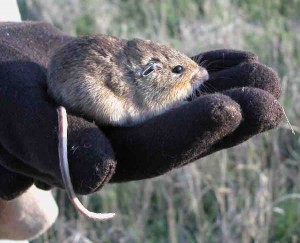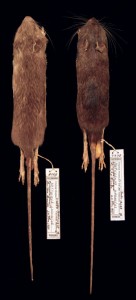New Mouse Discovered
Posted by: Loren Coleman on February 1st, 2010
Heteromys catopterius Discovered in Venezuela’s Coastal Range

While it might look like one of those mice coming into your house from outside, it isn’t. It’s a brand new species of rodent that has been recently discovered.
Dr. Robert P. Anderson, Associate Professor of Biology at The City College of New York, and Ph.D. student Eliécer E. Gutiérrez have reported the existence of a new species of spiny pocket mouse, from Venezuela, Heteromys catopterius.
The name derives from the Greek katoptêrios, which means a “height that commands a view.” It was chosen for the new species in reference to its presence on four wet, mountainous forest regions of the rugged and steep-sided Cordillera de la Costa along the country’s northern coast.
“Most people are surprised to learn that new species of mammals are still being discovered,” Professor Anderson said. “Sometimes they are discovered based on genetic work, but this is a case where anatomical studies made it clear a species existed that had never been recognized by biologists before.”
Several features differentiate the Overlook Spiny Pocket Mouse from the more common Heteromys anomalus, known as the Caribbean Spiny Pocket Mouse. H. catopterius has darker fur and lacks the distinctly rounded ears of H. anomalus. In addition, its skull is wider and less elongated. The Overlook Spiny Pocket Mouse is found in elevations ranging from 350 to 2,450 meters above sea level, although mostly above 700 meters. In contrast, H. anomalus resides mostly in lowlands and lower elevations of the mountains of the region.
The findings were published in the Bulletin of the American Museum of Natural History, in a Festschrift, a special volume in honor of Dr. Guy G. Musser, a curator at the museum who retired recently. The research was funded through a National Science Foundation grant.
In identifying a distinct species, researchers must look for data that indicate discrete morphologies, Professor Anderson explained. Further, they assess whether there is evidence for integration among the species.
“When you see gradual changes between locations, that is a sign that you do not have a distinct species,” he continued. “In this case, the species show very distinct morphology, even in the places where the vegetation types they inhabit come into contact.”
Professor Anderson, a leader in using GIS (geographic information systems) analysis to model species distributions (ranges), says his goal is to use the genus Heteromys as an example of how to integrate GIS, evolutionary biology and climate studies. With an aim toward conservation, he hopes to compare areas with suitable habitat for the species with the location of protected areas.
He and his collaborators at Brigham Young University and the Universidad Simón Bolívar are also currently performing genetic research to study evolutionary relationships in the genus. To complement this, Professor Anderson and his students are building GIS models of the species’ climatic requirements and applying them to reconstructions of past climates.
During the peak of the last Ice Age, when glaciers were extensive and temperatures were generally colder even in the tropics, distributions of this montane species were probably more contiguous, he explained. “We can take the same model of the species’ requirements and apply it to projections of future climate to predict what habitat will remain for the species as the climate gets warmer.”
He says it is likely that suitable habitats for this species will be reduced as a consequence of climate change. A GIS exercise studying the distribution of H. catopterius has been integrated into the laboratory of CCNY’s undergraduate biology course, “Ecology and Evolution.”
Source: The City College of New York press release.

The overlook spiny pocket mouse (right) is darker and longer than the more commonly known Caribbean spiny pocket mouse (left), according to CCNY biologists. Researchers determined the montane mouse was a new species after studying museum specimens. The mouse, which may have had a much wider range during the last Ice Age, when temperatures were cooler, may face a reduction in its habitat as climate changes, the researchers said.
Photograph by Eliécer E. Gutiérrez
About Loren Coleman
Loren Coleman is one of the world’s leading cryptozoologists, some say “the” leading living cryptozoologist. Certainly, he is acknowledged as the current living American researcher and writer who has most popularized cryptozoology in the late 20th and early 21st centuries.
Starting his fieldwork and investigations in 1960, after traveling and trekking extensively in pursuit of cryptozoological mysteries, Coleman began writing to share his experiences in 1969. An honorary member of Ivan T. Sanderson’s Society for the Investigation of the Unexplained in the 1970s, Coleman has been bestowed with similar honorary memberships of the North Idaho College Cryptozoology Club in 1983, and in subsequent years, that of the British Columbia Scientific Cryptozoology Club, CryptoSafari International, and other international organizations. He was also a Life Member and Benefactor of the International Society of Cryptozoology (now-defunct).
Loren Coleman’s daily blog, as a member of the Cryptomundo Team, served as an ongoing avenue of communication for the ever-growing body of cryptozoo news from 2005 through 2013. He returned as an infrequent contributor beginning Halloween week of 2015.
Coleman is the founder in 2003, and current director of the International Cryptozoology Museum in Portland, Maine.









